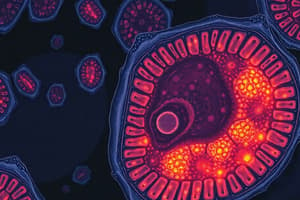Podcast
Questions and Answers
What is the primary role of organelles within a cell?
What is the primary role of organelles within a cell?
- Store water and nutrients for the cell
- Carry out special metabolic functions (correct)
- Maintain shape and structure of the cell
- Protect the cell membrane from damage
Which type of microscope provides the best resolution for observing cellular structures?
Which type of microscope provides the best resolution for observing cellular structures?
- Reflected light microscope
- Phase-contrast microscope
- Transmission electron microscope (correct)
- Light microscope
Which characteristic differentiates eukaryotic cells from prokaryotic cells?
Which characteristic differentiates eukaryotic cells from prokaryotic cells?
- Smaller size
- Presence of a nucleus (correct)
- Complex metabolic processes
- Presence of a cell wall
Which organelle is responsible for digesting and recycling materials in a human white blood cell?
Which organelle is responsible for digesting and recycling materials in a human white blood cell?
What is the function of the nucleolus within the nucleus?
What is the function of the nucleolus within the nucleus?
Which of the following correctly describes prokaryotes?
Which of the following correctly describes prokaryotes?
What structure forms the outer boundary of a eukaryotic cell?
What structure forms the outer boundary of a eukaryotic cell?
Which of the following substances are included in a biofilm?
Which of the following substances are included in a biofilm?
Flashcards are hidden until you start studying
Study Notes
Cell Definition
- The smallest unit of life
- Organelles are structures within a cell that carry out specific metabolic functions
Simple Animal Cell
- Cytoplasm is the gel-like substance within the cell membrane
- DNA carries genetic information
- The nucleus is the central organelle that contains DNA
- The nucleoid is the region where DNA is located in prokaryotes
- The cell membrane is the outer boundary of the cell
Types of Cells
Eukaryotic Cells
- Cells with a nucleus and other membrane-bound organelles
Prokaryotic Cells
- Small, simple cells without a nucleus
Modern Microscopes
- Light microscopes use visible light to illuminate and magnify specimens
- Phase-contrast microscopes enhance contrast in transparent specimens
- Reflected light microscopes illuminate the surface of opaque specimens
- Fluorescence microscopes use fluorescent dyes to illuminate specific structures
- Electron microscopes use beams of electrons to create highly magnified images
- Transmission electron microscopes (TEMs) create images by passing electrons through a thin specimen
- Scanning electron microscopes (SEMs) create 3D images by scanning a focused electron beam across the surface of a specimen
Prokaryotes
- Prokaryotes include bacteria and archaea
- They are the smallest and most metabolically diverse forms of life
- Prokaryotes are single-celled organisms
Biofilm
- A community of single-celled organisms that secrete a protective layer of polysaccharides and glycoproteins
- Examples include bacteria, algae, fungi, protists, and archaeans
Eukaryotic Cells
- All protists, fungi, plants, and animals are eukaryotic
- Eukaryotic cells have their DNA enclosed within a nucleus
- Organelles found in eukaryotic cells include:
- Cell wall: provides structural support and protection (in plants, fungi, and some protists)
- Vacuole: stores water, ions, and nutrients and helps maintain cell shape (larger in plant cells)
- Plasma membrane: regulates the passage of substances into and out of the cell
- Mitochondrion: the powerhouse of the cell, responsible for ATP production through cellular respiration
- Nucleus: the control center of the cell, containing DNA
- Central vacuole: a large, fluid-filled sac that stores water and provides structural support (in plant cells)
- Chloroplast: the site of photosynthesis in plants and some protists
- Cytoskeleton: a network of protein fibers that provides structural support, allows movement, and helps transport substances
- Microtubules: hollow tubes that help maintain cell shape, transport substances, and form components of cilia and flagella
- Microfilaments: thin filaments that help maintain cell shape, support cell movement, and form contractile structures
- Intermediate filaments: tough, rope-like filaments that provide structural support and help anchor organelles
- Plasmodesma: channels that connect the cytoplasm of adjacent plant cells
- Plasma membrane: controls the movement of substances into and out of the cell
- Ribosomes: sites of protein synthesis
- Rough ER: modifies proteins made by ribosomes attached to it
- Smooth ER: synthesizes lipids, breaks down carbohydrates and fats, and detoxifies substances
- Golgi Body: packages, modifies, and sorts lipids, enzymes, and proteins
- Lysosome-Like Vesicle: digests, recycles, and breaks down waste in the cell
Human White Blood Cell
- Organelles in a human white blood cell include:
- Rough ER: synthesizes and modifies proteins made by ribosomes attached to it
- Smooth ER: synthesizes lipids, breaks down carbohydrates and fats, and inactivates toxins
- Golgi Body: modifies, sorts, and packages lipids, enzymes, and proteins for delivery to other parts of the cell
- Lysosome: digests and recycles materials within the cell
- Nuclear pore: allows the passage of molecules between the nucleus and the cytoplasm
Structure of the Nucleon Envelope
- The nuclear envelope is a double membrane that surrounds the nucleus
- Proteins embedded in the nuclear envelope control the movement of molecules between the nucleus and the cytoplasm
Structure of the Nucleus
- Nucleoplasm: a viscous fluid contained within the nuclear envelope
- Nucleolus: a dense region in the nucleus where subunits of ribosomes are assembled from proteins and RNA
Studying That Suits You
Use AI to generate personalized quizzes and flashcards to suit your learning preferences.




